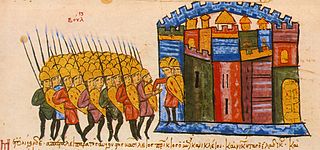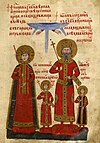Croatian–Bulgarian wars
You must add a |reason= parameter to this Cleanup template – replace it with {{Cleanup|reason=<Fill reason here>}}, or remove the Cleanup template.
This article needs additional citations for verification. |
| Croatian-Bulgarian Wars | |||||||||
|---|---|---|---|---|---|---|---|---|---|
| |||||||||
| Belligerents | |||||||||
|
| File:Croatia, Historic Coat of Arms.svgCroatia | ||||||||
| Commanders and leaders | |||||||||
|
Boris I Duke Alogobotur Samuil |
Trpimir Tomislav I Svetoslav Suronja | ||||||||
The Croatian-Bulgarian Wars were a series of conflicts that have erupted three times during 9th and 10th centuries between the medieval realms of Croatia and Bulgaria. During these wars, Croatia had formed alliances with Eastern Francia and Byzantium against the Bulgarian Empire.
First war
During middle of the 9th century, Bulgaria was the dominant power in the central, eastern and northern Balkans. In 854, Bulgarian ruler Boris I forged an official alliance with Moravian prince Rastislav against Louis the German of East Francia. Duke Trpimir of Croatia has been a faithful Frankish vassal and was weary of Bulgaria's ongoing expansion when it expanded to Croatian borders, after the wars against Rascia. Bulgaria invaded Croatia ca. 854[1], however there is also a possibility that King Louis gave some compensation to Trpimir to attack Bulgaria.[2]During the war of 854, there was only one great battle on the territory of present-day northeastern Bosnia, which ended without victors. Soon afterward, peace negotiations began between Boris of Bulgaria and Trpimir of Croatia, which ended with gifts exchanged and establishment of peace, with the border between the Croatian-Dalmatian Duchy and Bulgaria stabilizing on the river of Drina (between modern-day Bosnia and Herzegovina and Republic of Serbia).
Second war
A very long and arduous war was led between the Bulgarian Tsar Simeon I who wanted to take over the Byzantine Emperor and the Empire's monarch Romanos I. Heavily under pressure from the Bulgarians amassing defeat after defeat, the Byzantine empire negotiated with Serbia and Croatia in an effort to forge an alliance against the Bulgarians. Simeon was informed of these plans by Prince Mihailo Višević of Zachlumia was pressed to the islands as the Serbian rulers took direct control most of his local lands for themselves, so in 924 Simeon overran Serbia and through tricking its nobility destroyed it, making it a direct part of the Bulgarian Empire. Serbia's ruler Zaharija Pribislavljević fled and found exile at the Croatian court, while after the realm's destruction massive waves of Serb refugees fled and found refuge under Tomislav's Croatia. Trying to gain Croatian entry into this coalition, Romanos I ordered in ca. 925 the province of Dalmatia to pay taxes not to Byzantium but rather to the Croatian state [3]; the Dalmatian territories including most cities and the northern islands were henceforth administered by King Tomislav and would remain under Croatia since then. The Serbs of Zahumlje allied with Croatia and Prince Mihailo became Tomislav's vassal some time before 926. Tsar Simeon sent Duke Alogobotur to chase the Serb refugees further into Croatia, causing outright war in ca. 926.
The climax of the war was the Battle of the Bosnian Highlands on 27 May 927 when Croatian forces under command of King Tomislav completely defeated the Bulgarian forces under command of Alogobotur, killing most of the Bulgarians in the battle. The Croatian victory was so decisive and the battle was so big that contemporary sources greatly overestimated Croatia's Army to 160,000, with a slightly bigger force on the Bulgarian side [4]. That was the only battle Tsar Simeon ever lost. The war ended soon afterward with the pope's diplomatic help as both rulers were in good relationships with Pope John X without border change. Although pulling the eastern border down to the river of Bosnia, the Croatian realm went from the war greatly strengthened in the militaristic and natural ways as one of the most modern realms of then's age, consolidating a moderate navy. In the same day of the battle Simeon died in Preslav and his successor Peter I faced internal difficulties and revolts of his brothers Michail and Ivan. The Serbs used that and of them returned to their homes of the renewed Serbian realm by 931 terminating Croatia's short-lived Bulgarian neighbor at the east.
Third war
In the second half of the 10th century, the Croatian realm was ruled by Stjepan Držislav. Stjepan formed an alliance with the Eastern Roman Empire, which in turn recognized him as the King of his lands [5]. After his death in 997, his son Svetoslav Suronja continued his pro-Byzantine policy. His brothers Krešimir III and Gojslav didn't want Svetoslav for ruler and attempted a coup d'etat, asking for help from the Bulgarian tsar Samuil. Answering their call, Samuil went on a rampage in 998 raising the Dalmatian cities of Trogir and Split, but was stopped at the siege of Zadar. Once stopped, the Bulgarian forces returned to their home country [6] using Bosnian route. Territory taken by Samuil during the war was given to Krešimir III and Gojslav, who, with further Bulgarian support, won the Croatian civil war and took over the realm in the year 1000. Byzantine and Venetian ally, Svetoslav Suronja, was sent to exile in Venice, but was after change of Venice government exiled to Hungary. After the fall of Bulgaria under Byzantine rule following Ivan Vladislav's death in 1018, Krešimir III and Gojslav, the two Croatian kings, became Byzantine vassals.
Footnotes
- ^ De Administrando Imperio
- ^ К. Грот, Известия о сербах и хорватах, стр. 125—127
- ^ Tempore Joannis pape sanctissimo consulatu peragente in provincia Croatorum et Dalmatiarum finibus Tamisclao rege et Michael in suis finibus presidente duce
- ^ De Administrando Imperio, 948, Constantine VII Porphyrogenitos
- ^ Recipiebant enim regie dignitatis insignia ab imperatoribus Constantinopolitanis et dicebantur eorum eparchi siue patritii
- ^ Chronicle of the Priest of Duklja






